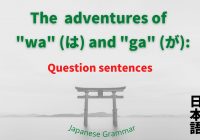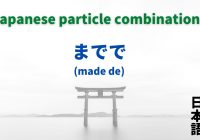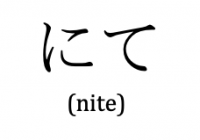Tag Archives: particles
Japanese particle combination: “made de” (までで)
I feel that grammar is the soul of a language, and in the case of Japanese, particles are one of the most important parts of grammar. In this post I’d like to go over the particle combination “made de” (までで), which may not be obvious the first time you spot it in the wild. I… Read More »
Japanese particle combination: にも (ni mo)
In this blog I’ve written quite a few articles on Japanese grammar, particularly about particles, one of the tricker areas to master. In this article I’d like to talk about にも (ni mo), a commonly used particle combination. Fortunately, a majority of the time にも can be understood by simply combining the meaning of these… Read More »
Particle combination かで (kade)
Particles––small words that can have a big impact on the meaning and nuance of a sentence––are arguably one of the most difficult things to master in Japanese grammar (the other being various forms of politeness). Over time I’ve written a bunch of posts about particles, which you can see here. This time I would like… Read More »
Don’t underestimate Japanese particles!
Japanese particle: にて (nite)
In this post I’d like to go over the word “nite”, which is generally written in hiragana as にて. While one of my Japanese/Japanese dictionaries has a full six meanings for this word, fortunately in modern Japanese the use is somewhat limited and easy to understand. “nite” is classified as a “case particle” (格助詞), which… Read More »
A tale of particles: “ni” (に) vs “wo” (を), the verb “kizuku” (気づく), and a bus full of moles
Particles––small words that have big grammatical meaning––are one of the challenges to real mastery of Japanese. The particles “wo” (を) and “ni”(に) generally have fairly defined roles. “wo” is used when something is the direct object of an action (ex: りんごを食べる / eat an apple) whereas “ni” is used for the direction of an action… Read More »
Literary particle combination: をば (wo ba)
In a recent article, I mentioned how the particle を (wo or o) is usually not used in combination with other particles, except for “をも” (wo mo) which you can occasionally see in literature. However I came across another combination involving を I wanted to talk about, just to set the record straight: をば (wo… Read More »
A simple explanation of the particles wa (は) vs ga (が)and the surprising equation “1+1=2”
I’ve dedicated a great deal of my time to having a good understanding of Japanese grammar, and proper usage of the particles “wa” and “ga” is one of the tricker areas. I’ve written some posts on this topic, and you can find many others if you google around. I am not going to go into a… Read More »
The mysterious case of the double wo (を) particle
Japanese particles can be tricky because of their many usages and combinations. For example 「で」 can be seen with other particles in the two-particle pair 「では」or 「での」 or even in the 4-particle combination 「ならではの」. On the other hand, the 「を」 particle (written as ‘wo’ or just ‘o’), is one of the most straightforward to learn.… Read More »





